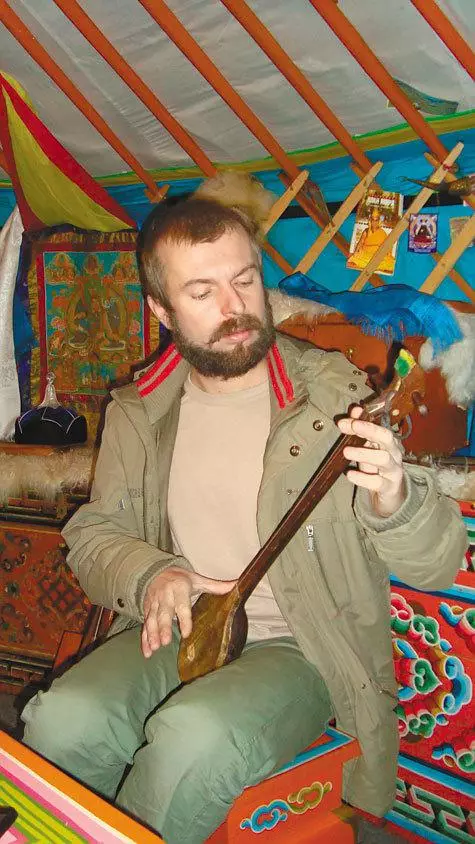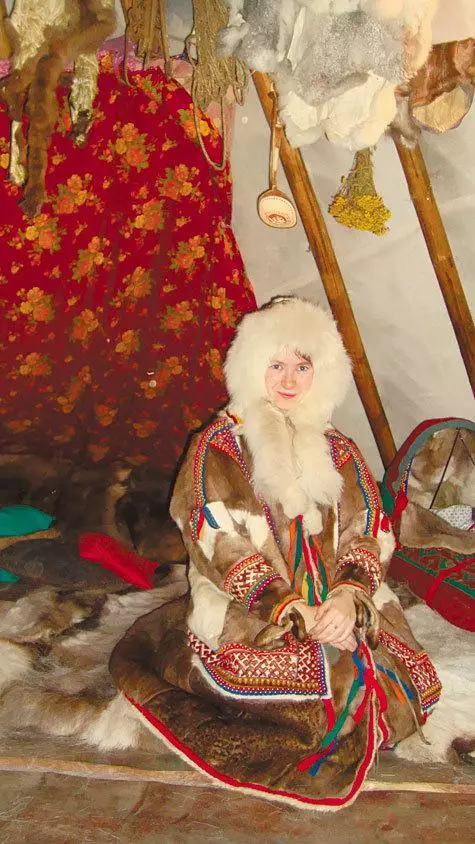I did not immediately find a nomadic oasis. Looking from Aviamotor Street - An ordinary yard: an old five-story school, an iron fence, a sports ground ... And suddenly, when I already thought to turn back, in front of me there were different magnitude and shape of the house of nomads - yurts, plague, yarangi. From the carved gate with the inscription "Museum of Nomadic Culture" appeared a noisy swarm of second colleges. Teachers hurry: Enough, it's time to leave. But the guys, as if enchanted, get stuck in one exhibit, then another.
"We work on the principle of the Living Museum," said Konstantin Kuxin director of this amazing focus. - We have all the exhibits can be touching with your hands, to plunge into the life of nomads, to join their traditions. In general, as if visiting.

Konstantin Kuksin.
The director leads me in his possessions, showing the Yurt-Headquarters, where the first manifestic talent of George Zhukov appeared for the first time, then an elegant kibituka of a notable Mongolian girl, the Bedouin Tent in a huge metal case - to protect against harsh metropolitan weather.
"For example, this yurt differs from the usual, in which Mongols live, only by fire safety sensors, - continues the excursion Konstantin Valerievich. - In all horses, real, typical things are collected for one or another people. And, accordingly, in each house has its own program dedicated to the folk religion, culture, everyday life ... Children can shoot from Luke, make an amulet. We carry out the rite of Mongol tea drinking. And, of course, let me play in the game common among nomads. For example, in Mongolian puzzles or in Alchiki - "Barani bones".
I am also trying to disassemble a simple look at first glance, but a very unusual wooden puzzle. Then we go to the spacious yurt, where a thirty-thirty-five man is easily placed during excursions.
- Such a yurt put women hour and a half or two, "says Konstantin Valerievich. - Men, as it should be, give the ladies easier work. I somehow tried myself in the role of a reindeer - it was necessary to say, there was no harder in my life. It accounted for a whole day to run in deep snow so that no one leave deer unattended for a minute. Compared to this, the assembly of the yurt is just a pleasure. By the way, sometimes in the extreme north you need to move to a new pasture every day. And my friend's wife, when two weeks stood on one site, just could not find the place: "When will we touch on the road?".

Maja guide.
* * *
... in the street slush and cold. And here, in the yurt, somehow it is immediately warm and joyful - whether the bright paints of the tent decoration are pleased, whether unusual items are expressing the imagination. Musical instruments, luxury skins, an old mirror - everyone wants to consider feeling. On the massive wooden table - the lamb is a blade. "It is used for fortune telling: there will be a juicy grass, a lot of livestock will be born," Konstantin Valerevich explains me. Weak smells of wool. I'm interested in the creator of the museum: where did such love for nomadic culture come from?
"For the first time in Mongolia, I got in 2002," he recalls. - announced bike ride from Baikal to China. And when we drove through the territory of Mongolia, I was simply shocked by her beauties, a culture that we do not know at all. And I wanted to return there.
A young school teacher geography not only "fell ill" Mongolia, but also "infected" her student. They began to ride in the expedition, master the language, traditions, beliefs of nomadic peoples. And, of course, the idea of the museum appeared - so I wanted that as many people as possible learned and loved this country.
"Thanks to the director of the School of Roman Alekseevich Reuel, who allowed our exhibits on its territory, and also helps us with a decision of household, organizational issues," says Konstantin Kucun. - We consider the birthday of the museum on January 12, 2004, when we cleared our first exhibit - this is this old Mongolian yurt. You needed signatures of three Russian ministers so that this humanitarian assistance of the Mongolian people Russian (yes, I am not kidding, so it was me!) Missed on the border.
Gradually, the collection has grown, now there are 11 large objects - traditional houses of nomadic peoples. Geography is diverse: from those who are sewn from the skin of the tents of the deserts of the deserts of the peoples of the Far North, the deer fur of the peoples of the peoples of the nodes. I think that here, perhaps, try to argue the immense.
- Nomads will always understand each other, - the guide seems to read my thoughts. - Even despite the huge distances that share them, in everyday life, customs, the attitude towards their lives in common. For example, a guest is a gift. As the Mongolian Proverb says: "Happy the owner, whose house is grazing a guest horse." And, by the way, almost everywhere - from Kazakhstan to Mongolia and Libya - with great respect refer to research on our outstanding historian-ethnographer Lion Gumilyov and successfully embody his ideas to life.
* * *
Some of the assistants of the director constantly comes to the tent. Very young guys report that they came from school and ready to clean the horses. Their museum is two: what kind of nomad and without a horse! Then the guide of Maya comes - disguises in a real national costume to carry out the next excursion.
"The most valuable thing in our museum is people," says director. - I have stunning staff! All expedition members are people who are passionate, bright and unusual. For example, Sasha Terekhin is a historian, an ethnographer, a researcher of the indigenous culture of the Far North of Russia. It takes an active part in the creation of nomadic schools for children of reindeer breeders. And how she sings the songs of the peoples of the Far North - hear! Volodya Chushchenov - Traveler and artist, he designed the first Buddhist temple in Moscow. Volodya studies the culture of dyers. He teaches in the Cadet Corps and writes the book "Three words about Lomonosov and the Sea". Maya Galeeva - Expeditions Participant in the most hard-to-reach regions of the planet. She explores traditional rites and beliefs of nomadic peoples and even received a dedication from the female of the people of Tsaatatan ("Oleni people") in Northern Mongolia. And she also translator and poetess - a collection of her lyrics came out recently.
By the way, the guide in the museum is the most honoraory position. To become them, you must first go through the course of the "young fighter" - to work as a volunteer, then go to the expedition (if you show yourself with a worthy and passionate person), and at the end of the present exam - come up with and write a business project of your own museum. According to the director, several unique ideas are waiting for incarnation.
We leave the yurt. Konstantin Kucunin enthusiastically talks about Buddhism (there is even a small Buddhist temple on the territory of the museum) and shamanisa. About how two or three and even five religions are organically intertwined in some nomadic peoples. About how the nomads of old people are respected, as children love. Remembers that the steppes are easy to meet the shepherd with a candidate or doctoral degree. After all, in the east, a person learns to find his place in life. And to the modern goods of civilization there are very restrained: only what really and imperceptibly improves life is used.

On the street to slush and cold, and in the yurt warm and joyful.
* * *
I have long needed to leave, and I did not really have time to consider even the decoration of one yurt. I want to come here along with friends to enjoy the stories of experienced travelers, their songs, verses and unusual Mongolian tea.
- What did the nomadic teach you the most important? - I'm interested in Konstantin already at the gate.
"I became more calm," the director of the museum thoughtfully pronounces. - As one Chukchi told me, when I annoyed: "Imagine, the Purga began. Five days from Yarangi can not go out. Sit, think. " I learned to stop, look at life. I can say, I as a person formed a nomadic culture - and not only me, but also my employees.
